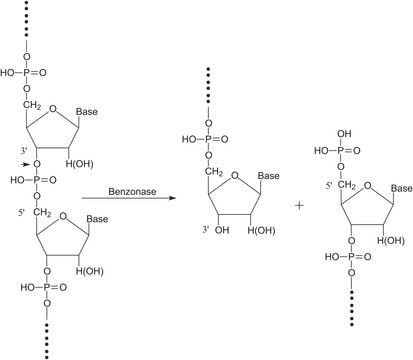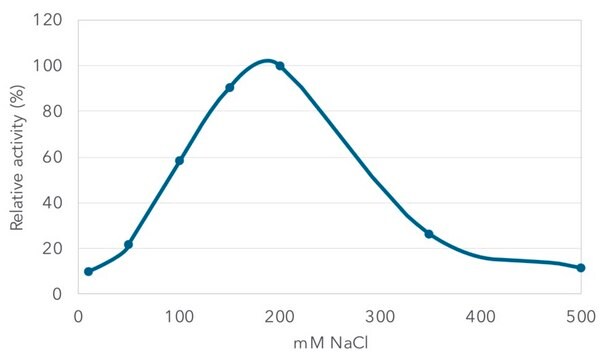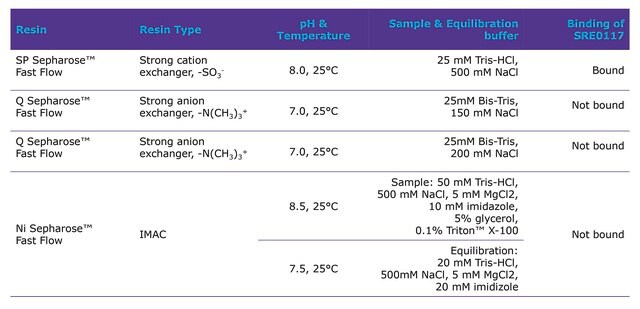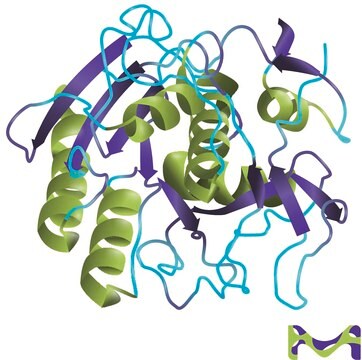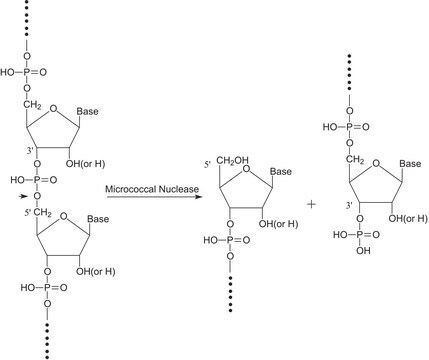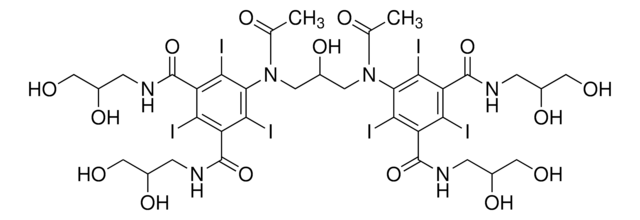SRE0015
Salt Active Nuclease (SAN)
recombinant, expressed in Pichia pastoris
Sinonimo/i:
Endonucelase, Salt active endonuclease
Autenticatiper visualizzare i prezzi riservati alla tua organizzazione & contrattuali
About This Item
Codice UNSPSC:
12352204
NACRES:
NA.54
Prodotti consigliati
Origine biologica
fermentation/recombinant
Livello qualitativo
Ricombinante
expressed in Pichia pastoris
Stato
buffered aqueous glycerol solution
Attività specifica
≥250000 U/mg
tecniche
DNA extraction: suitable
Compatibilità
suitable for nucleic acid purification
applicazioni
cell analysis
Condizioni di spedizione
wet ice
Temperatura di conservazione
−20°C
Categorie correlate
Applicazioni
Salt active nuclease has been used to remove DNA during protein expression and purification.
Azioni biochim/fisiol
Salt active nuclease (SAN) is a general, unspecific endonuclease that cleaves double-stranded and single-stranded DNA, and RNA. SAN is active at above neutral pH. Unlike other nucleases, however, it has optimum activity at high concentrations of salt at high pH. These qualities make SAN ideal for removal of DNA from cell extracts and protein samples. The end-products upon complete degradation of DNA consist of a majority of 5 nucleotide
oligos. The enzyme degrades DNA vs. RNA in a ratio of 10:1.
SAN is highly active over the temperature range 10-40 °C. The optimal NaCl-concentration for activity is 0.5 M. However, SAN is active in low salt buffers. 1 M NaCl is not recommended for use of SAN. Mg2+ (>1 mM) is required for activity. The pH working range is above neutral pH, with an optimal range between pH 8.5-9.5
Physical form: Solution in 25 mM Tris-HCl (pH 7.5), 5 mM MgCl2, 0.5 M NaCl, 0.01% Triton, and 50% (v/v) glycerol
Unit definition: One unit (U) is defined as an increase in absorbance at 260 nm of 1 Absorbance Unit in 30 minutes at 37 ºC, using 50 μg/ml calf thymus DNA in a buffer with 25 mM Tris-HCl (pH 8.5, 25 ºC), 5 mM MgCl2, and 500 mM NaCl.
oligos. The enzyme degrades DNA vs. RNA in a ratio of 10:1.
SAN is highly active over the temperature range 10-40 °C. The optimal NaCl-concentration for activity is 0.5 M. However, SAN is active in low salt buffers. 1 M NaCl is not recommended for use of SAN. Mg2+ (>1 mM) is required for activity. The pH working range is above neutral pH, with an optimal range between pH 8.5-9.5
Physical form: Solution in 25 mM Tris-HCl (pH 7.5), 5 mM MgCl2, 0.5 M NaCl, 0.01% Triton, and 50% (v/v) glycerol
Unit definition: One unit (U) is defined as an increase in absorbance at 260 nm of 1 Absorbance Unit in 30 minutes at 37 ºC, using 50 μg/ml calf thymus DNA in a buffer with 25 mM Tris-HCl (pH 8.5, 25 ºC), 5 mM MgCl2, and 500 mM NaCl.
Definizione di unità
One unit (U) is defined as an increase in absorbance at 260 nm of 1 absorbance unit (AU) in 30 minutes at 37 °C, using 50 μg/ml calf thymus DNA in a buffer with 25 mM Tris-HCl (pH 8.5, 25 °C), 5 mM MgCl2, and 500 mM NaCl.
Codice della classe di stoccaggio
10 - Combustible liquids
Classe di pericolosità dell'acqua (WGK)
WGK 2
Punto d’infiammabilità (°F)
Not applicable
Punto d’infiammabilità (°C)
Not applicable
Scegli una delle versioni più recenti:
Possiedi già questo prodotto?
I documenti relativi ai prodotti acquistati recentemente sono disponibili nell’Archivio dei documenti.
I clienti hanno visto anche
Transcriptome engineering with RNA-targeting type VI-D CRISPR effectors
Konermann S, et al.
Cell, 665-676 (2018)
Il team dei nostri ricercatori vanta grande esperienza in tutte le aree della ricerca quali Life Science, scienza dei materiali, sintesi chimica, cromatografia, discipline analitiche, ecc..
Contatta l'Assistenza Tecnica.